|
February 16, 2006
A Follow-Up Interview with Sue Kenney and
Her Documentary on the Camino de Santiago: A Pilgrim Continues Her
Journey
My good friend Sue Kenney left the
corporate world a few years ago and went on a pilgrimage on the
famous Camino de Santiago, a truly life-changing event for her.
Since then Sue has written a best-selling book called
"My Camino", she has recorded a story-telling CD,
has become a sought-after speaker, seminar leader and personal coach.
The Camino has become her new life.
There is always something interesting going on in Sue's life. Last
year in particular Sue took a group of pilgrims on the Camino with
her and created a documentary about this profound experience.
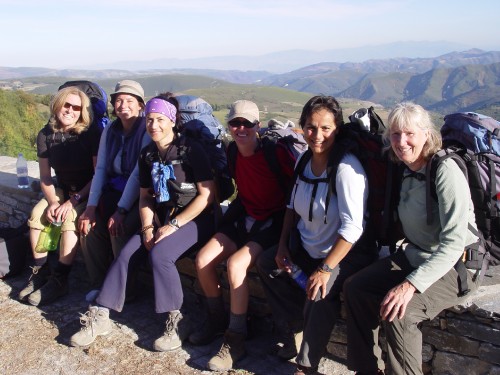
Sue Kenney (far left) and her group of pilgrims
(c) Pasha
Patriki
I had a chance to catch up with Sue again and see what she has
been up to.
1. We last chatted
last year in May. What is new since then? What have you been
working on?
I've been working on co-writing a screenplay with Bruce Pirrie,
my writing partner and editor, based on the book I wrote called
My Camino. I have also taken a group of 5 women on a journey walking
240 kms on the Camino and filmed a documentary about it. I am in
the editing process of my second book, Confessions of a Pilgrim.
I have attached a chapter from the book. I have had two of my poems
published in a book commorating the Huntsville Poetry Fringe Festival.
My leadership/writing/Camino coaching business is booming. I have
a number of clients I am coaching as they go through the process
of writing a book; a number of clients who I work with on a weekly
bases to prepare to walk 800 kms of the Camino alone in the fall,
and a couple of business executives I work with too.
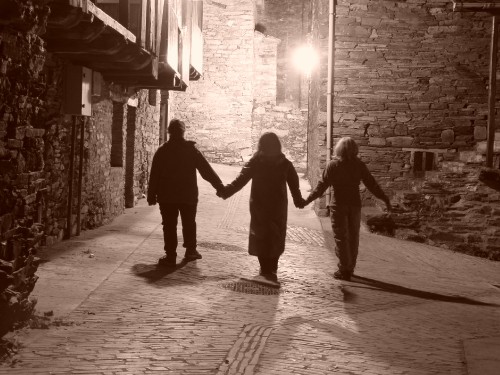
(c) Pasha
Patriki
2. Of course one of the big news is your October trip to
the Camino which you turned into a documentary. Please tell us about
the preparations leading up to the trip and the work involved in
preparing for a documentary.
Inititally I was approached by a women who had terminal breast cancer,
to take her and her girlfriends on the Camino. When I added this
to my web site, I had a number of people interested in joining us
on the journey. A Toronto production company wanted to do a documentary
about me and I agreed to co-produce it. I spent a couple of months
prior to the journey providing a weekly training program and answering
questions about preparation for the Camino. Due to other commitments
with the launch of their feature film, they had to back out of the
documentary. But since I had the journey already planned and agreement
from the people walking to being a part of a documentary, I considered
cancelling the project since I had never been a film maker or directed
a documentary and I didn't have the funding needed. Once I decided
to take on the project myself, in one month I raised the additional
funding, hired a Director of Photography and developed the storyboard.
Unfortunately, the woman who asked me to take her on the path had
to cancel because of her health. By now I had 5 other women signed
up and we were ready to go.
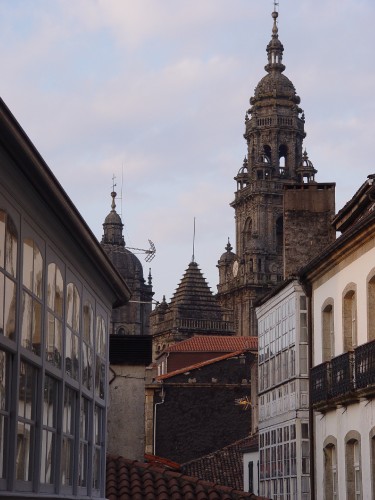
(c) Pasha
Patriki
3. What about the trip itself? How long was it? What was
the itinerary?
240 kms. We travelled from Toronto to Madrid and then rented a van.
I drove the van to Ponferrada, then on to the Valley of Silence,
a mystical site located in the mountains. We stayed the night there
and drove back to Ponferrada, and then walked on average 20kms a
day to arrive in Santiago over 11 days.
4. How many people joined you on this trip? What about the
make-up of the travel group? What were your co-pilgrims' motivations
to go on the Camino?
There were 5 pilgrims, myself and we had a cameraman, Sasha
Patriki, with us. Here are my pilgrims:
Mony Dojeiji, a 40 year old Lebanese,
Canadian MBA, former business executive in the software industry,
and now a master pilgrim. Strong willed and assertive, Mony represents
hard-core pilgrim values and struggles with her natural inclination
to take charge. A soldier for peace, Mony assumes the role of a
veteran sergeant in the group. [I did an interview last year with
Mony about her 5000 km Walk for Peace,
another very interesting woman.]
Anita D’Amario is a 44 year old business executive first generation
Canadian Italian. She’s optimistic and ready for a possibly
difficult journey, which she does indeed experience. It’s
Anita who raises possibly the most interesting question on the journey;
“How much do we have to suffer in order to be happy?”
Margie McParland, a 56 year old retired teacher and mother of
five children, is a world traveler and loves to hike. “Some
people came on this journey to find out who they are, I know who
I am.” She came not expecting to have a religious experience
but winds up mothering, mentoring and teaching two pilgrims how
to pray the rosary.
Anita Shuper is a 33 year old MBA graduate who has survived ovarian
cancer and saw this journey as an opportunity for personal growth.
She hates the sunshine, loves rain, adores cats and composes music
along the way. Naturally funny and a source of comic relief, she
experiences what is possibly the most profound emotional and spiritual
transformation of all the pilgrims.
Laura Cooper is a 30-something divorced mother of two children.
The smallest of the group, she is private, introspective and quiet.
Yet, days before the end of the journey, she finally asserts her
feelings to the group, forcing everyone to face the true purpose
of their journey.
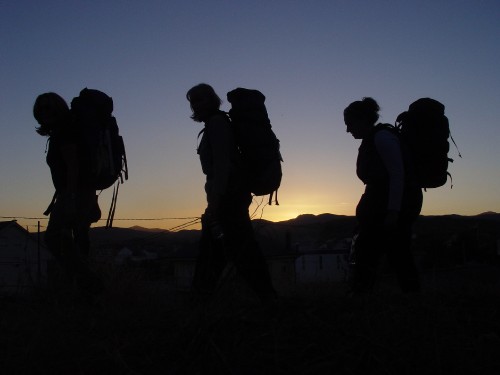
(c) Pasha
Patriki
5. Please tell us about the beginning of your most recent
walk on the Camino. You also had an interesting experience in a
place called the Valle del Silencio.
I drove a 7 passenger van from Madrid to the Valley of Silence
about 15kms outside of Ponferrada. We had to drive on very narrow
roads that were cut into the edge of a mountain. The van barely
fit and often we had to stop and back up to find enough space to
let another vehicle pass. I was very nervous about being responsible
for all the people in the van on these dangerous roads, although
I somehow trusted the Camino would take care of us. When we finally
reached the valley, we parked the car. It was dark and we began
to look for the refugio. We soon found out it was closed for the
winter. We were told there was no where to sleep. There was no way
that I was going to drive back down the mountain in the dark. We
walked the streets asking people along the way for their help. We
were turned down by everyone. Finally, we approached a women with
a number of kids around her. She said there was a lady named Generosa
who lived down the road and might have a place for us. We went to
her home and knocked on the door. She came to the window on the
second floor and called out to us. We pleaded with her for a place
to sleep. She agreed it would be 20 euro for the night. She came
downstairs and took us across the narrow road, up some old wooden
stairs into a barn. We looked around, there was one mattress and
a piece of foam. We were all so tired we didn't care. We had bought
a bottle of locally made liguor called Herjabo (I think). We passed
the bottle around and told stories. Then we rolled out our sleeping
bags on the wooden planks and fell asleep. It was very cold in the
night, well below zero and it was very uncomfortable. This certainly
put us all into a pilgrim mode.
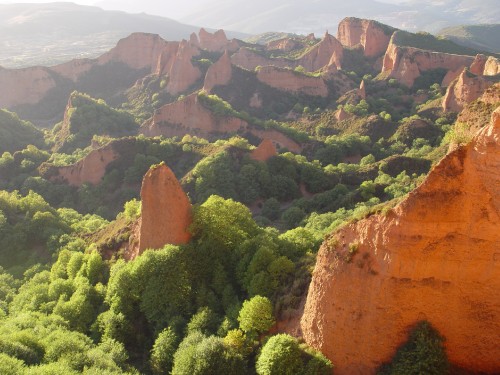
(c) Pasha
Patriki
6. Please tell us about the progression of your trip. What
was your daily routine? Where did you stay? What did you eat? How
did your co-pilgrims adjust to the Camino?
We stayed in hostels for pilgrims. Each day started with daily impressions
spoken into the camera we set up outside the hostel.Throughout the
day we would walk alone at times and as a group. We always spent
dinner together and stayed in the same hostel. We supported each
other through conversation and offering assistance. Some of the
pilgrims got blisters and this required special treatment.
7. One of the days provided for a 33 km long walk, a rather
monstrous physical challenge. Please tell us about that day and
why no footage exists of this unique day.
The day we walked 35kms, the camera man had an injury. He pulled
his achilles tendant and had to take a taxi part of the way. Then
when the pilgrims arrived at the destination, they were so exhausted,
he helped them by carrying their packs for the last 500 meters.
That night we had dinner together, but very little footage was captured.
I thought it would be the highlight of the documentary, but I assumed
that the Camino wanted to show the world something different.

(c) Pasha
Patriki
8. What was it like to be a tour leader, pilgrim and documentary
creator at the same time?
It was a difficult challenge. Often I had to be a pilgrim, a leader,
a director/producer, a travel guide, first aid, a mom and a friend
all at the same time. I had to juggle different roles and also walk
and carry my own backpack. But most of all, I was a leader. I tried
to remain as aware and present as possible and trust that everything
would work out. I struggled with a leader style. I wanted to be
out front guiding the pilgrims, but that wasn't were I ended up.
I came to the conclusion that I would allow the pilgrims to experience
their own journey, and try to guide them towards Santiago, allowing
them a chance to discover things for themselves. This was a discipline.
Part way through the journey, I was given a walking stick by a villager
who stopped me along the way. The stick was very short, ornately
carved and crooked in shape. The villager asked me to take it to
Santiago and pray for him and his wife when I got there. I was committed
to using the stick as I walked but it was too short. It took a lot
of patience and persistence to use it, but I had promised the man.
One day I was walking in a small village and noticed a shepherd
with some sheep. He was herding them into a fenced in area. I noticed
that he stood at the back of the flock, tapping the sheep who tried
to separate or head in the wrong direction. From this experience,
I learned that I wanted to be like that shepherd and guide the pilgrims
on their way. Besides, I realized it would be useless to stand in
front of them and try to get them to follow me. It was a fabulous
lesson in leadership for me.
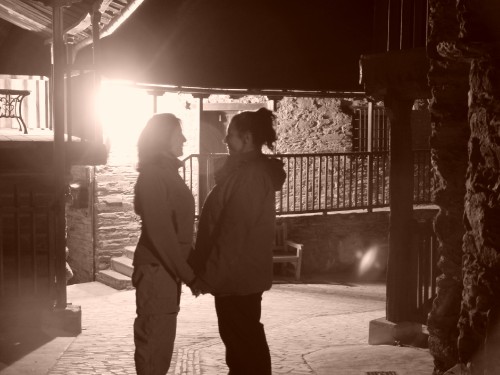
(c) Pasha
Patriki
9. Please comment on the group dynamics among the pilgrims
that joined you.
This group was very supportive of each other.They were open to each
other and very accepting. I think even more so than any situation
at home. The Camino teaches humility and openess. The more one opens
up to the Camino, the more one receives.
10. Please tell us about your arrival in Santiago de Compostela
and your experiences at the end of the trip.
The arrival in Santiago was a bit of a let down, as usual. It's
the end of the journey, and the beginning of something new. It's
so interesting to meet people on the path and have the time to walk
alone that it's a little dissappointing when it's over. We were
blessed with the swinging of the botafumero, a giant insense censor,
on the two days we were in the city. We have amazing footage for
the documentary. Each person went through the rituals of hugging
the statue of the Apostle and joined in the pilgrims mass where
our names were announced. There are many rituals and customs that
have carried on making us feel a part of something quite special.
11. What lies ahead for you now in completing this documentary?
We have completed a demo reel (5 mins) of the documentary and
now will try to get a broadcast licence or ideally, a deal with
the National Film Board. There is a distributor who is interested
in taking the demo to Cannes in the spring and hopefully that will
be a reality. I truly believe the Camino will find a way into the
heart of those who want to experience it. My role is to tell a story
to inspire people to be on a journey, whether it's here or in Spain.
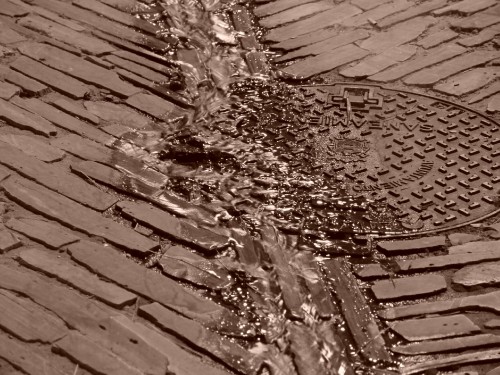
(c) Pasha
Patriki
12. What is next on the agenda on the Camino of Life for
Sue Kenney?
My purpose in life is to inspire people on their life journey to
live from a place of love through stories. I live the Camino in
everything I do. I believe that intention and all the experiences
of my life, will take me to places I never dreamed of being. My
mother always told me I can be anything I want to be and I believe
that to be true for anyone. Not long ago I remember a radio interviewer
asked me if I ever thought I would be interviewed on the radio as
an author of a book, and what did I think of that now. I told her,
"It's like a dream I never thought I had, came true."
As always, Sue, you have been doing some very interesting things.
Thank you for filling us in on all the new developments in your
life and all the best for completing your documentary! Keep in touch....
Related Articles:
My earlier interview with Sue Kenney
An interview preview providing
more background
Sue's presentation
about the Camino
I played hooky
with Sue last May
|